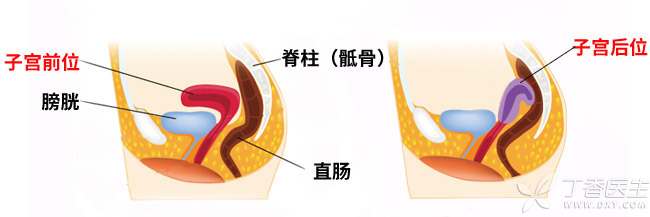
Now physical examination is becoming more and more popular, entrance examination, company physical examination, pre-pregnancy physical examination… and married women’s physical examination is usually without vaginal color Doppler ultrasound. Some women will always seriously study after getting color Doppler ultrasound reports, and study every professional term, [uterus posterior position] is one of them.
I believe [posterior position of uterus] must have frightened many people, because the content found on the Internet is often like this:
The posterior position of uterus will cause dysmenorrhea.
The posterior position of uterus is easy to lead to infertility.
Women in the posterior position of the uterus should raise their hips or even stand on their heads after having sex, which can improve the chances of conception.
So, the posterior position of the uterus seems to have become a serious problem. Is this really the case?
What is the posterior position of the uterus?
The position of the uterus in the body can be roughly divided into the anterior position and the posterior position. What about the two states of how?
We can imagine such a scene, in the classroom between classes, some students sleep on desks and some lean back on chairs.
The uterus of different women also has these two states in the body. Some uterus [lie prone] on the anterior bladder, and some uterus [lean back] on the posterior rectum and spine.
According to statistics, about 20% of women are in the posterior position of the uterus, so the posterior position of the uterus is not uncommon.

Why is the uterus posterior?
Most posterior positions of the uterus are congenital. However, some reasons may also lead to the transition of the anterior uterus to the posterior position:
1. Pregnancy
During pregnancy, the uterus enlarges and the ligaments that fix the position of the uterus become loose. As a result, some women will find that the uterus has become posterior after giving birth.
2. Menopause
When the estrogen level of women decreases after menopause, the body will undergo some changes, such as relaxation of ligaments fixing the uterus, and then the uterus may change from anterior position to posterior position.
3. Diseases of the reproductive system
Some diseases, such as pelvic inflammatory disease and endometriosis, can cause the uterus to tilt back. These diseases can cause scar tissue in the abdominal cavity, thus causing the uterus to move. In addition, tumors in the uterus itself or surrounding organs may also cause the uterus to change its position.
Will the posterior position of the uterus lead to infertility?
The causes of the posterior position of the uterus include diseases of the reproductive system, among which pelvic inflammatory disease, tumors and other diseases will affect the probability of pregnancy.
However, the change of uterine position caused by these diseases is not only the simple posterior position of the uterus, but also the symptoms of other diseases, such as small stomachache and menstrual disorder.
For this kind of posterior uterine position, the key to solving infertility is to treat the diseases that cause infertility and posterior uterine position, rather than treating the manifestation of posterior uterine position.
As for congenital and posterior uterine position after pregnancy, there is no direct research to prove that it will affect pregnancy, and indeed there is no research to prove that it will not affect pregnancy. The big reason is that this phenomenon is very common and harmless, and there is no need to devote energy to study this matter.
However, we can indirectly show that the posterior uterus has little to do with pregnancy through a set of data comparison: about 20% of the people have posterior uterus; However, the incidence rate of infertility is 10% ~ 15%, and most of the causes are clear, such as ovulation disorder, endometriosis, endometritis, etc. Only a few of the causes of infertility are unknown.
Therefore, if it is not said that [the posterior position of the uterus will lead to infertility], it can only be said that [this possibility is not ruled out, but it is definitely the probability of winning the first prize].
Will the posterior position of the uterus lead to dysmenorrhea?
Dysmenorrhea can be divided into primary dysmenorrhea and secondary dysmenorrhea.
Primary dysmenorrhea means that dysmenorrhea has no organ diseases and no clear etiology. This kind of dysmenorrhea accounts for 90% of dysmenorrhea. At present, some scholars do believe that [the posterior position of uterus can cause dysmenorrhea], which may be related to poor menstrual blood discharge. In addition, pelvic congestion during menstruation and posterior position of uterus close to rectum and lumbosacral region can also be manifested as defecation and lumbosacral pain before menstruation and during menstruation.
Secondary dysmenorrhea refers to dysmenorrhea caused by diseases, including endometriosis and adenomyosis.
What about the posterior position of uterus?
Is it useful to raise your hips during the rumored sex and stand on your handstand after the sex?
Since the posterior position of the uterus is not the main cause of infertility, if someone is willing to make such an attempt, there is nothing to say.
What needs to be emphasized is that parents who want a baby but are not pregnant must not rush to the doctor.
If there is no contraception and the sexual life is normal, and you are still not pregnant one year later, you should seek the help of a doctor in the reproductive center of a regular hospital or an obstetrician and gynecologist, instead of just looking for a [child-sending hospital] or a folk prescription, which has wasted money and delayed the birth time.
